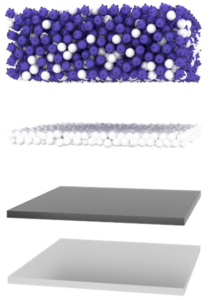SOLBAT – Solid State Metal Anode Batteries
The ambition of SOLBAT is to demonstrate the feasibility of a solid-state battery with performance superior to Li-ion in electric vehicle (EV) applications. An all-solid-state battery would revolutionise the EVs of the future and profoundly impact the consumer electronics and aerospace sectors. The successful implementation of a lithium metal negative electrode and the replacement of the flammable organic liquid electrolytes currently used in Li-ion batteries with a solid would increase the range, decrease the charging time, and address safety concerns.
SOLBAT was established to address fundamental research challenges facing the realisation of solid-state batteries. Significant progress has been made including: understanding the role of voiding at the lithium-solid electrolyte interface on discharge, and the mechanism of lithium dendrite ingress and crack propagation/short circuit on charge; developing and implementing of a new method of solid electrolyte materials discovery; and understanding the effect of volume change in composite cathodes. SOLBAT is now using this fundamental understanding to provide solutions to these challenges.
Organised around three research areas, namely anode, cathode and electrolyte, with cross-cutting characterisation & modelling activities, the project aims to prevent dendrites and voiding, minimise operating pressure and facilitate scaling.
Timeline with milestone/deliverables
Anode
- Investigate structural changes during alloying and interfacial stability (March 2024)
- Understand the effect of interlayers on plating, stripping and critical current density (March 2024)
- Prepare and test new alloys and interlayers (March 2025)
- Clarify the effect of the current collector, interlayers and formation cycle in Li-less cells (March 2025)
Cathode (March 2025)
- Synthesise polymers with targeted electrochemo-mechanical properties for use as binders and coatings for use in composite cathodes
- Demonstrate effect of composite cathode microstructure on performance and optimisation
Electrolyte (March 2025)
- Investigate effect of particle size, processing and secondary phases on densification, microstructure, mechanical properties and supressing dendrites
- Understand how the ceramic microstructure, density, grain size, shape, and particle surface composition affect the grain boundary resistances
- Determine degradation mechanism of sulfide solid electrolytes in air and develop mitigation strategies to reduce moisture sensitivity
- Develop models at the particle, component and cell level to guide materials research and microstructural design
Project innovations
SOLBAT will tackle the barriers to realising solid-state batteries that are at the research level. New intellectual property will be developed and ideally converted into viable businesses by industrial partners and/or newly created commercialisation vehicles. Ultimately, a long-term effort in developing a strong and substantial core knowledge will provide a strong foundation for the commercialisation of this technology.

Representation of solid-state battery structure
Project funding
£21.8m
1 March 2018 - 31 March 2025
Principal Investigator
Professor Mauro Pasta
University of Oxford

Project Manager
Neil Cadman
University of Oxford
University Partners
University of Oxford (Lead)
Newcastle University
Research Organisations, Facilities and Institutes
Diamond Light Source
+ 3 major Industrial Partners


Comments are closed.